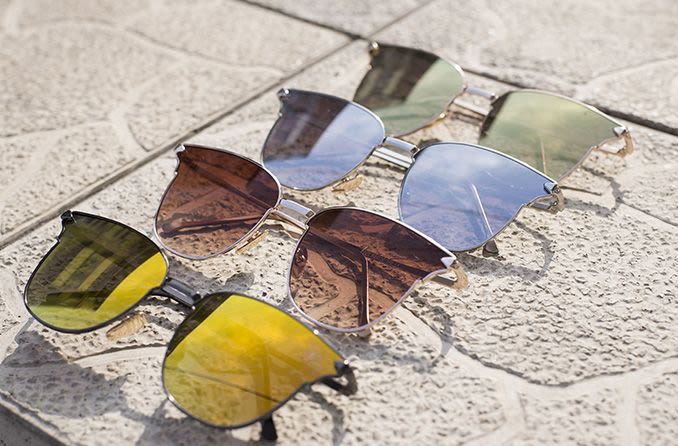UV protection is the first and foremost purpose of sunglasses. The color of your sunglass lenses is not an indicator of how much UV blocking protection your sunglasses will provide. Color does matter when choosing sunglasses with other benefits. When choosing colored lenses, consider lifestyle, work, recreational activities, and how you plan to use your sunglasses. Each color is used to enhance and improve vision under specific circumstances.
Gray/Black tint reduces glare especially when on the water. Also, it is a good color for shielding bright light. Gray/Black tint works well on both cloudy and sunny days. It is great for driving by providing anti-fatigue benefits.
Brown or amber tint reduces glare, blocks blue light, brightens vision on cloudy days, and increases contrast in visual acuity.
Green tint can do what gray and brown do, but better. Greenish colored lenses help to provide contrast by filtering out blue light. It helps to reduce glare and eyestrain in brighter sunlight by transmitting color accuracy.
Yellow tint provides greater clarity in fog, haze, snow, and other low light conditions. This tint tends to make objects appear sharper but can cause color distortion. Yellow shades can be helpful at night time as they increase contrast.
Blue tint reduces glare, helps to see contour around objects more clearly, and improves color perception. Blue tint provides protection from reflective surfaces and works well in foggy and misty weather. Blue is fashionable and is cosmetically appealing with many skin tones.
Red/Rose tint increases depth of field and enhances detail. It increases contrast and visual acuity especially against blue or green background. It is more comfortable and can be worn for an extended period of time than other colors.
Sunglass lenses that are treated with a colorless, UV-absorbing coating offer UV protection up to 100%. Clear lenses that are coated with the same coating will block the same amount of UV light. Sunglasses designed to block 100% of UVA and UVB rays will protect against cumulative damage to your eyes. Consult your eye doctor about your current prescription.
Polarized or non-polarized is another choice to be made when looking for sunglasses. Polarized and non-polarized sunglasses both darken a bright day, but that’s where their similarities end. Many people notice the biggest difference between the polarized and non-polarized sunglasses when they are outdoors. The special coating on polarized lenses is highly anti-reflective, filters out ambient light and reduces haze and glare.
Non-polarized lenses treat all sunlight equally and reduce the overall intensity. This offers protection for the eyes but will not tackle shimmer and sparkle if you’re around water, snow, or glass. Non-polarized are preferred when viewing LCD screens while wearing, viewing objects like white surfaces are more true to color and are more durable than treated lenses.
Contact Heather, our eyegotcha optician, by calling 412.331.9696. She can help with options pertaining to which color lenses, UV protection and coating are best for your individual needs. Call 412.331.9696.
We carry sunglass lines by:
- Oakley
- Ray-Ban
- Nine West
- Candies
#eyegotcha
#PittsburghEyeCare
#PittsburghOptometrist
Sources:

